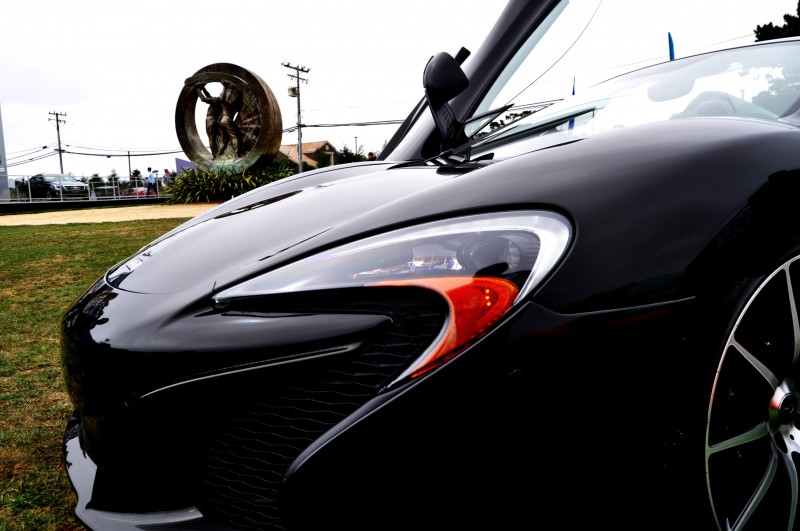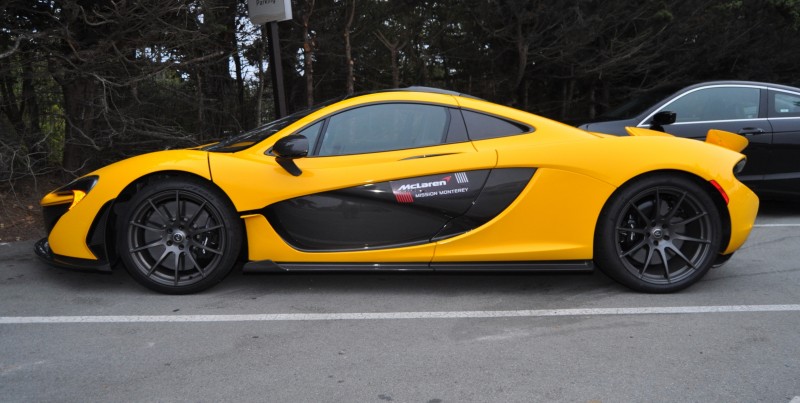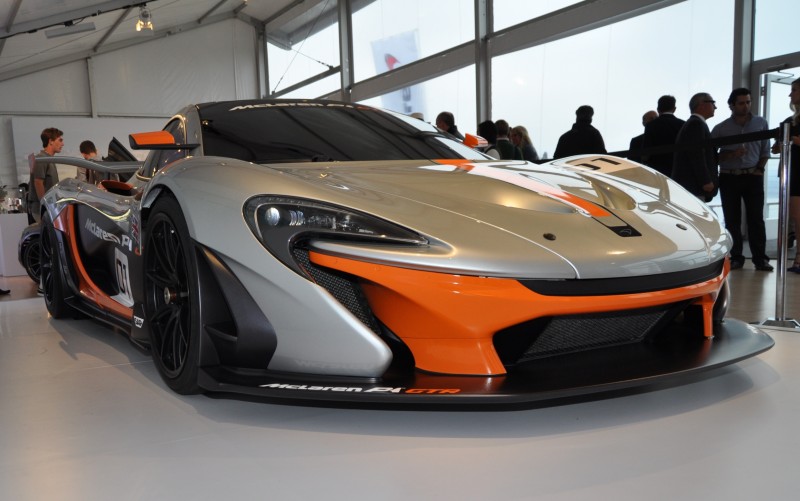Here is an interesting bit of news! McLaren has launched the new 625C with features custom-tailored to the exploding Asian market. New tuning and settings for the ProActive Chassis Control lets the hydraulic suspension of the 650S become boulevard-smooth in its comfort setting – far cushier than anything with the McLaren badge to date.
This is news because the 650S is already one of the smoothest-riding supercars ever made. That hydaulic suspension lets the car flow and breathe over bumps like a Citroen DS, but is adjustable in two further modes to make it track-hard.
Below you can see some of the McLaren 650S’s suspension components in the exposed-chassis demo car for Pebble Beach.
The 625C will still be just as focused in its more-extreme settings, but the option of a softer ride was deemed especially important for Asian clientele.
Here is yet another place where McLaren and Ferrari differ! Can you imagine presenting an idea like this at Maranello? You’d be scoffed at and laughed out of the conference room!
2015 McLaren 625C
THE McLAREN 625C: THE FIRST REGIONALLY TAILORED McLAREN MODEL
26/09/14
-
New more refined and more accessible McLaren 625C created for the increasingly important Asian market
-
Based on the globally available 650S
-
Coupe and Spider models available from launch
As McLaren continues to grow its presence globally, the British sportscar maker has announced plans for its first regionally tailored model aimed at the Asian market. The new McLaren 625C offers the greatest level of refinement of any McLaren model to date, combined with the optimised driving dynamics all McLarens are famous for.
The Asian market has seen the biggest area of growth for McLaren Automotive over the past two years, not least with the entry into China in September 2013. Sales are set to grow from 20 percent in 2013 to more than a third in 2014.
The McLaren 625C is being launched in response to customer demand in the Asian region, sharing the visual drama of the 650S, but with an increased focus on day-to-day usability and comfort. Through revisions to the groundbreaking ProActive Chassis Control and the suspension hardware, the driving dynamics and ride quality are further optimised. The end result is another no-compromise sportscar, offering class-defining levels of performance and quality, and taking refinement to a new level.
The name of the 625C refers to the power output of the highly efficient derivative of the 3.8-litre twin turbo V8 powerplant – 625PS (616bhp). ‘C’ stands for ‘Club’, highlighting a more accessible and less extreme model in terms of character. However, the McLaren 625C enjoys a number of the technical advances already debuted on the McLaren 650S.
2015 McLaren 650S
With a power output of 625PS (616 bhp), enhancements have been made to driveability and efficiency with engine torque of 610Nm (450 lb ft). Acceleration from zero to 100 km/h (62 mph) takes just 3.1 seconds, while 200 km/h (124 mph) is reached in 8.8 seconds for the Coupé. Despite the lower power of the 625C, maximum speed mirrors that of the 650S, at 333 km/h (207mph) [329 km/h (204 mph) for Spider], and CO2 emissions remain the same, at 275 g/km.
New dampers and revised mechanical balance give the McLaren 625C the most refined ride of any McLaren model to date. The bespoke set up, with a less stiff spring rate at the rear, ensure a sharp response with no loss in ride comfort through the ProActive Chassis Control system in ‘Normal’ mode, without any compromise to handling or performance in ‘Sport’ and ‘Track’ modes, offering.
The new McLaren 625C will initially be launched in Hong Kong, with Coupe and Spider bodystyles both immediately available. Selected other markets across the Asia Pacific region will be announced in the coming months.
TECHNICAL AND PERFORMANCE FIGURES
TECHNICAL SPECIFICATION – McLaren 625C Coupe
Drivetrain Layout |
Longitudinal Mid-Engine, RWD |
|
Track, F/R (mm) |
1656 / 1583 |
Engine Configuration |
V8 Twin Turbo / 3799cc |
|
Length (mm) |
4512 |
EnginePS / rpm |
625 / 7250 |
|
Width (mm) |
2093 |
Torque Nm / rpm |
610 / 3000-7000 |
|
Height (mm) |
1199 |
Transmission |
7 Speed SSG |
|
Dry Weight (kg / lbs) |
1336 / 2945 |
Body Structure |
Carbon Fibre MonoCell withAluminium Front and Rear Frames |
|
Active Aerodynamics |
McLaren Airbrake |
Wheelbase (mm) |
2670 |
|
Suspension |
ProActive Chassis Control |
Brakes |
Cast Iron Discs with Forged Aluminium Hubs (F 370mm/R 350mm) |
|
ProActive Chassis Control modes |
Normal / Sport / Track |
Tyres (F/R) |
Pirelli P Zero™235/35 R19/Pirelli P Zero™305/30 R20 |
|
Powertrain Modes |
Winter / Normal / Sport / Track |
Wheel Sizes (F/R) |
19” x 8.5”J / 20” x 11” J |
|
|
|
PERFORMANCE DATA
Efficiency |
CO2 |
275 g/km |
|
|
Fuel consumption (combined) |
24.2 mpg |
|
|
Power to weight – with lightweight options |
480PS (473 bhp) /tonne |
|
|
CO2/power |
0.45 g/km per PS |
|
|
|
|
Speed |
Maximum speed |
333 km/h (207 mph) |
|
|
|
|
Acceleration |
0-100 kph (62 mph) |
3.1 s* |
|
|
0-200 kph (124 mph) |
8.8 s* |
|
|
0-300 kph (186 mph) |
26.7 s* |
|
|
0-400m / ¼ mile |
10.6s @136 mph |
* with optional fit Pirelli P Zero™ Corsa tyres
TECHNICAL SPECIFICATION – McLaren 625C Spider
Drivetrain Layout |
Longitudinal Mid-Engine, RWD |
|
Track, F/R (mm) |
1656 / 1583 |
Engine Configuration |
V8 Twin Turbo / 3799cc |
|
Length (mm) |
4512 |
EnginePS / rpm |
625 / 7250 |
|
Width (mm) |
2093 |
Torque Nm / rpm |
610 / 3000-7000 |
|
Height (mm) |
1199 |
Transmission |
7 Speed SSG |
|
Dry Weight (kg / lbs) |
1376 / 3034 |
Body Structure |
Carbon Fibre MonoCell withAluminium Front and Rear Frames |
|
Active Aerodynamics |
McLaren Airbrake |
Wheelbase (mm) |
2670 |
|
Suspension |
ProActive Chassis Control |
Brakes |
Cast Iron Discs with Forged Aluminium Hubs (F 370mm/R 350mm) |
|
ProActive Chassis Control modes |
Normal / Sport / Track |
Tyres (F/R) |
Pirelli P Zero™235/35 R19/Pirelli P Zero™305/30 R20 |
|
Powertrain Modes |
Winter / Normal / Sport / Track |
Wheel Sizes (F/R) |
19” x 8.5”J / 20” x 11” J |
|
|
|
PERFORMANCE DATA
Efficiency |
CO2 |
275 g/km |
|
|
Fuel consumption (combined) |
24.2 mpg |
|
|
Power to weight – with lightweight options |
466 PS (459 bhp) /tonne |
|
|
CO2/power |
0.44 g/km per PS |
|
|
|
|
Speed |
Maximum speed |
329 km/h (204 mph) |
|
|
|
|
Acceleration |
0-100 kph (62 mph) |
3.1 s* |
|
|
0-200 kph (124 mph) |
9.0 s* |
|
|
0-300 kph (186 mph) |
27.7 s* |
|
|
0-400m / ¼ mile |
10.8s @134 mph |
* with optional fit Pirelli P Zero™ Corsa tyres
About McLaren Automotive:
McLaren Automotive is a British manufacturer of luxury, high-performance sports cars, located at the McLaren Technology Centre (MTC) in Woking, Surrey.
Following the company’s global launch in 2010, McLaren Automotive launched the groundbreaking 12C and 12C Spider and followed this in 2013 with the limited-run McLaren P1™. In keeping with its plan to introduce a new model each year, the company recently unveiled the 650S Coupe and 650S Spider. The brand continues to expand, operating through a dedicated global network of retailers in every major automotive market.
McLaren Automotive Partners
To support the development, engineering and manufacture of its range of innovative and highly acclaimed sports cars, McLaren Automotive has partnered with world leading companies to provide specialist expertise and technology. These include Akebono, AkzoNobel, ExxonMobil, Pirelli, SAP and TAG Heuer.
Designed for the track; Developed for the road
The connection between Formula 1 and road cars at McLaren is a natural process of experience, knowledge, principles and process transfer. Through the integration of 50 years of Formula 1™ racing expertise and knowledge, and over 20 years of heritage in producing landmark sports cars, McLaren Automotive designs, develops and builds a range of technologically advanced and groundbreaking high performance sports cars which are designed to be a no compromise drive on both road and track.
McLaren has pioneered the use of carbon fibre in vehicle production over the past 30 years, and since introducing a carbon chassis into racing and road cars with the 1981 McLaren MP4/1 and 1993 McLaren F1 respectively, McLaren has not built a car without a carbon fibre chassis.

Tom Burkart is the founder and managing editor of Car-Revs-Daily.com, an innovative and rapidly-expanding automotive news magazine.
He holds a Journalism JBA degree from the University of Wisconsin – Madison. Tom currently resides in Charleston, South Carolina with his two amazing dogs, Drake and Tank.
Mr. Burkart is available for all questions and concerns by email Tom(at)car-revs-daily.com.

























